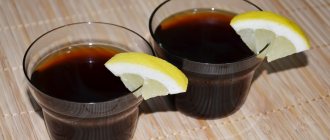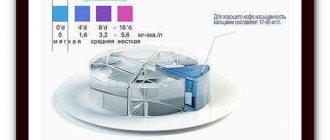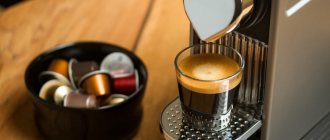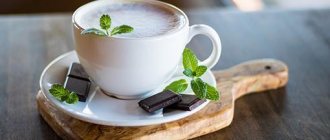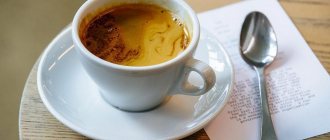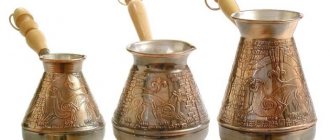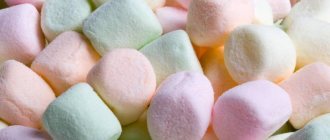Enjoy your coffee!
There is always room for experimentation - try different grains, change the grind size, add clear juices - apple or cherry - to the water. Try adding coffee to the top flask immediately after raising a small amount of water, wait until the water has completely risen, remove the burner and place a few ice cubes or frozen fruit slices in the top flask to stop the brewing process.
Life hack: A siphon is also an excellent device for brewing not only coffee, but also tea; try brewing Pu-erh in it, and you will get an excellent tea drink.
Read our articles about how to make coffee in other coffee gadgets.
Advantages and disadvantages
Let's summarize and describe the pros and cons of the Gabeta siphon for coffee. Let's start with the positive points:
- Siphon coffee has its own unique taste and is definitely worth trying.
- If you choose one of the retro variations of siphons, you have the opportunity to enjoy a unique spectacle, the process of preparing this ancient drink from the gabeta siphon.
- You can make not only coffee, but also excellent tea. You can't do this in a regular coffee machine.
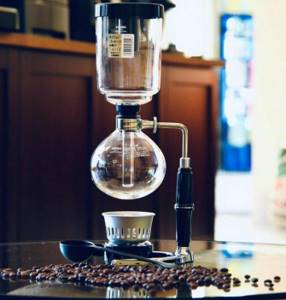
Minuses:
- the price for branded devices is quite high
- Siphon flasks are quite fragile and need to be handled with care.

How to make tea in a siphon
A siphon for brewing tea is a complex device; you need to know how to use it. The main thing is to follow safety precautions when working with a hot glass device.
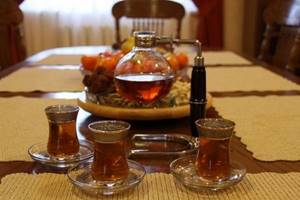
Safety regulations
- Do not touch the siphon flasks with bare hands; you must use cloth gloves or a special napkin.
- The flasks are made of durable glass, but it can break. They must be handled very carefully. If the bulb accidentally hits something, but there is no visible damage, it is better to test it. To do this, we brew tea at full operating cycle in safe conditions.
- You need to be extremely careful with the burner. It needs to be refilled only after it has cooled completely, away from heating devices and sources of fire. Gas for lighters cannot be used.
- Continuous heating of the siphon for more than ten minutes is not allowed. More than five cycles of tea preparation without a break are not allowed. The bottom flask will easily overheat and burst. The siphon should cool naturally.
- The siphon needs to be washed periodically.
You may be interested in: Tea brewing temperature, practical recommendations
Siphon operating principle
Before starting work, it is necessary to check the design of the siphon. The filter must be secured to the upper flask using a spring. The spring itself is fixed in a tense position using a special hook extending from the edge of the connecting tube.
The device works on the principle of gas expansion when heated. You need to pour hot water into one of the flasks, and pour the tea leaves into the second, which is connected to the first glass tube. The water in the lower flask heats up and begins to bubble, rising into the upper flask. The process of bubbling, rather than boiling, allows the water to become saturated with oxygen, which has a beneficial effect on the taste and benefits of tea. The process takes from 30 seconds to a minute. By changing the strength of the burner flame, you can adjust the intensity of the boiling.
The tea in the top flask can be stirred with a wooden stick by removing the top lid. When the tea is ready, the burner is turned off and removed. The plastic cover is removed from the top flask, and the drink falls down with a special “zilch.”
You can start disassembling the tea siphon. The flasks are removed using gloves. The top flask is pulled out and carefully placed on the inverted lid. The tea should not be thrown away; it can be brewed again.
From the lower flask, tea is poured into bowls or poured into an intermediate teapot. This will allow the drink to cool slightly and allow it to mix well. The entire cooking process takes no more than ten minutes.
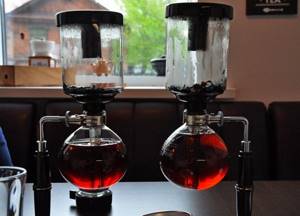
What can you cook in a siphon?
The tea siphon can be used for more than just standard tea or coffee preparation. Oolongs, puerhs and hibiscus are best brewed in this device.
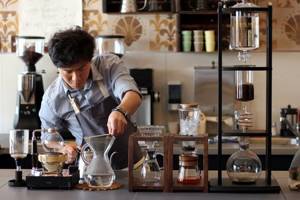
You can also prepare a variety of tea cocktails, during the preparation of which all components are mixed immediately before brewing in a siphon flask from above. Tea siphons are ideally suited for preparing tea with aromatic herbs, such as thyme, linden or mint, because the aroma is extracted from the raw materials in a special way. This tea comes out with an incredible, new sound. Be sure to compare the prepared drink in a kettle and in a siphon, and, most likely, you will like the latter much more.
And finally, the main advantage of the siphon is the ability to experiment with different teas and other ingredients.
Tea siphon: history
The siphon was originally invented in France for brewing coffee. In 1839, Madame Joan Richard received the first patent for such a unit. Three years later, in 1841, Madame Vasier created and patented another version of the siphon. And it was this second patented device that became the prototype of modern siphons.
Due to the fact that Vasier's prototypes had transparent glass flasks, coffee preparation became more spectacular, and its brewing smoothly moved into the salon from the kitchen. Unfortunately, the flasks burst at the slightest overheating. Inventors tried to solve this problem, but to no avail. Therefore, the brilliant invention had to be forgotten for half a century.
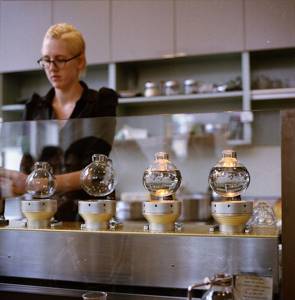
At the end of the 19th and beginning of the 20th century, similar devices began to appear in the United States. In 1914, the inventors solved the problem of flask overheating and patented the unit in the USA and a little later in England. Overheating occurred due to the fact that the drink was poured through the tap, and in new versions of siphons the drink flowed through the neck from the lower flask to the upper one.
In the 20th century, siphons continued to be improved. Shapes and glass were constantly improved, as were the types of filters. However, these devices did not become widespread, since coffee makers were more practical and convenient. And that is why few people know about an alternative method of brewing coffee and tea.
Now let's make coffee! )))
We fix the lower flask on the stand, fill it with water, install the upper flask with a filter and light the burner.

The instructions instruct you to first simply lower the “trunk” of the lower flask into the water, wait until the water begins to boil, and only then finally install the upper flask. In fact, this is wildly inconvenient, because... the seal is very tight and in order to install the flask properly, you need to firmly grasp both flasks with your hands, and with hot flasks this is quite an attraction. The water gradually begins to boil...
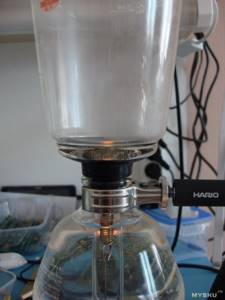
... and move to the upper flask

All the water is at the top. Now we reduce the heat to a minimum: it is necessary to find a balance to avoid excessive boiling of the water in the upper flask, and at the same time to prevent a drop in the steam pressure in the lower flask, because in this case the water will go back down.
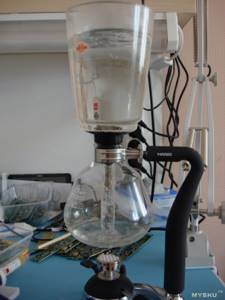
While the water was boiling, the coffee grinder had already ground a portion of coffee.
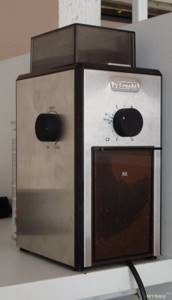
I came across mentions that for each type of coffee the degree of grinding is selected individually, but experiments have shown that you can use one for everyone. But the amount of coffee per brew really needs to vary depending on the type, because... The strength is different. In the photo of the coffee grinder you can see the signatures of the varieties around the coffee quantity regulator. My coffee grinder is simple, with flat millstones. I was going to order an advanced one with conical ones, but the ruble happened, what happened, and now, against the backdrop of sluggish renovations in the apartment, everything is generally sad... A little about storing coffee
Immediately after roasting, the coffee begins to lose its aroma. Until the coffee is ground, this process proceeds rather slowly, but after 3-4 weeks the coffee will “turn into pumpkin” - the taste will become flat and inexpressive, all flavor nuances will disappear. Moreover, 3-4 weeks is if the coffee is stored in an opaque, tightly closed container. That is why it makes no sense to buy bean coffee in supermarkets, where only the expiration date is indicated on the packaging, or in “specialized” departments where coffee is stored in transparent, unsealed jars. The shelf life of roasted beans can be extended by a couple of months by freezing them, but this is a one-time trick. The lifespan of ground coffee is even shorter - 10-15 minutes. This leads to three main points: the coffee must be freshly roasted, it must be stored properly, and it must be ground immediately before preparation. The most problem-free moment is grinding: I bought a coffee grinder and everything is fine (now I’m deliberately simplifying and taking out of the equation all the subtleties of choosing a coffee grinder, since this is a very voluminous issue). Everyone decides the issue of storage depending on their own sense of beauty. Personally, I use a dark glass jar with a sealed lid to store chemicals. The hardest thing is finding a coffee supplier. On a personal note, I highly recommend the Torrefacto company. A bunch of delicious varieties, roasted every week and fast delivery - what more could a real Indian want))). This insert is not paid for, and is my way of saying a huge thank you to the company's employees for their valiant work.
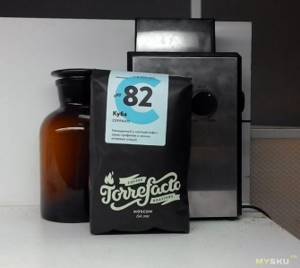
Pour ground coffee into water...
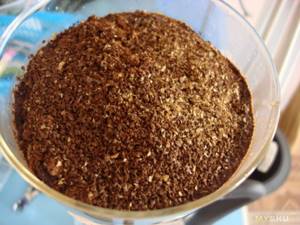
...mix...
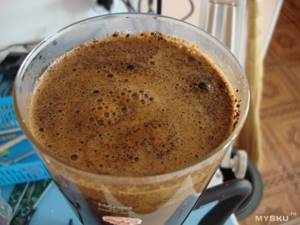
... and start the timer.

The main purpose of stirring is to evenly wet the entire volume of ground coffee. It is more convenient to do this with “poke” movements of a teaspoon. The brewing time is also selected individually once, depending on taste preferences (we brew longer - the coffee will be richer, but it may begin to taste unpleasantly bitter). The timer chirped, we turn off the burner, mix the contents of the upper flask again (this time in order to “wash away” the most delicious coffee particles into the water) and after ten seconds the brewed coffee begins its return journey to the lower flask.
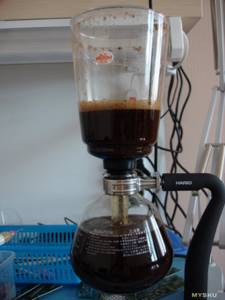
But what remains in the upper flask.
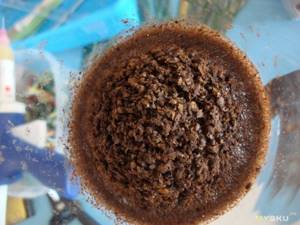
Remove the top flask and pour the finished coffee into a mug. In the lower flask there remains part of the sediment of coffee particles that have leaked through the filter.

About the same amount of sediment ends up in the mug.
“Where is the mug?” ©

Enjoy your coffee!
Preparing coffee in a siphon
Step-by-step cooking instructions:
- Heat water in a kettle until boiling. Its quantity should correspond to the volume of the lower flask, no more.
- Attach a pre-moistened filter to the top flask.
- Pour heated water into the bottom flask.
- Light the burner and place it under the siphon.
- As it boils, place the top flask.
- When the water starts to rise, reduce the flame on the burner.
- Grind coffee beans in a coffee grinder.
- Add coffee and stir gently. It must be completely soaked in water.
- Allow the drink to steep for 1 minute.
- Gradually the drink moves to the lower part of the siphon, the coffee grounds remain on top.
- Carefully remove the top part.
After such actions, the finished drink can be poured into cups.
Gabet (siphon) or how to get the most delicious cup of coffee
Few people are familiar with such a device for making tea and coffee as a siphon (or gabette), but it is siphons that allow you to reveal the most subtle flavor nuances of the drink and get an exceptionally clean and complex cup. In appearance, the siphon resembles laboratory equipment, so for most it is not immediately clear how tea or coffee can be brewed in such a device. Let's take a closer look at the siphon.
For most people, the word siphon is associated with a sink drainage element or an underwater tunnel (if you are familiar with hydrography), but not with a device for making amazing tea or coffee. A siphon is a vacuum coffee maker invented in the 1930s in Germany. The first patent for a vacuum coffee maker was filed in France in 1835. After which siphons quickly gained popularity throughout Europe. At that time, gabets looked very beautiful and had a lot of decorative elements - coffee in a siphon in the 19th century was prepared not in the kitchen, but in the living room, in the presence of guests. The cooking process was an enchanting performance, and the gabets themselves were a luxury, an advanced invention and a prestigious attribute.
The siphon was not only popular in many European countries, but also made its way to the United States, where the first patent for a vacuum coffee maker was filed in 1894. Gabetes were actively used until the middle of the 20th century, after which their popularity gradually waned, which many blame on instant coffee, which began to become widespread after the Second World War. Since the seventies of the 20th century, only a few companies, including the famous Asian Hario and Yama and the Danish Bodum, have been producing high-quality gadgets.
Today, siphons are once again gaining popularity among gourmets, coffee connoisseurs and baristas. The rebirth of vacuum coffee makers is primarily due to the excellent quality of the resulting drink. The siphon allows you to extract the fullness of taste and aroma. Today, siphon coffee can be found in many specialty coffee shops and bars in the United States and Europe.
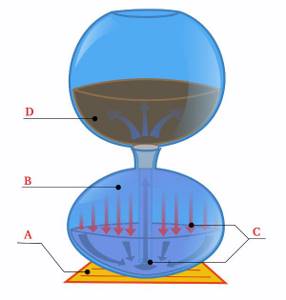
The siphon consists of two glass vessels - upper and lower, between which a rubber gasket is installed. The upper vessel is a glass flask with a tube that almost reaches the bottom of the lower vessel. Water is poured into the lower vessel and a burner (A) is installed under the siphon. The water in the lower vessel heats up, its molecules expand and become a gas, increasing the pressure in the lower vessel (B). Due to the increase in pressure, water (C) begins to rise to the top of the siphon (D). Now you can add coffee to the upper vessel, stir and let it brew, then turn off the burner under the siphon. After turning off the burner, the temperature drops and the water molecules contract, which causes the pressure to drop below atmospheric pressure and create a vacuum, due to which the water is sucked back into the lower vessel, leaving the coffee grounds in the upper one. The taste of the drink is very delicate and soft, but at the same time clean and complex.
Although the process of how the gabette works is described above using a coffee example, the siphon produces excellent teas and tea cocktails. It is not for nothing that well-known Asian companies (Hario, Yama and Tayli) are the best manufacturers of high-quality siphons on the market. Asia is the birthplace of tea and many Asian gourmets cannot imagine their life without siphon tea. I understand them very much - gabette is simply irreplaceable for brewing pu-erhs, oolongs and preparing amazing tea cocktails with fresh mint, ginger or lemon zest. You can brew almost any tea in a siphon and create unique cocktails (recipes are limited only by your imagination).
Today, high-quality borosilicate glass siphons are produced by a number of companies, of which Hario, Bodum, Cona and Yama should be highlighted. Personally, I really like siphons from the Japanese ]Hario[/anchor], especially the NXA-5 model because of the excellent design, quality and the presence of two filters - metal and fabric, but this is personal preference. Below is the official two-minute video about him
On a note!
To find your taste in the drink, I recommend experimenting with extraction time, amount of coffee/tea and water, coffee grind and water temperature.
PS. Step-by-step instructions for making coffee in a siphon in pictures can be found here.
